-
Car Reviews
- Car News
-
Car Comparisons
Latest comparisons
- Chasing Deals
Ahead of its showroom debut in late 2023, Chasing Cars was granted the opportunity to test Nissan’s factory-backed Patrol Warrior 4×4 on private roads and trails
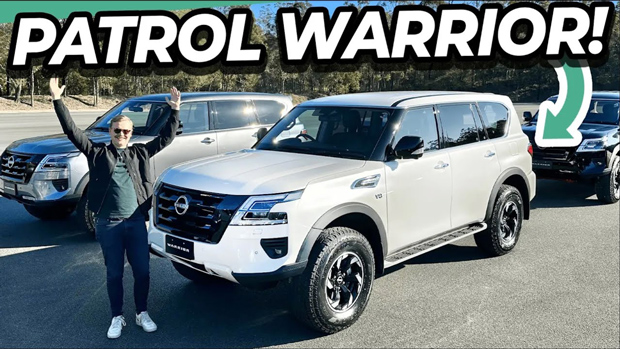
Having flourished after the conclusion of all major car manufacturing in Australia, Nissan Australia’s partnership with Melbourne vehicle modification and subassembly specialist Premcar has developed into a respectable green-shoot of local automotive engineering know-how.
Having spawned three varieties of the quietly well-regarded Navara Warrior ute with a fully Australian-developed suspension and greatly improved road manners when compared to its donor pick-up, the Nissan–Premcar partnership has turned to something with a bit more power.
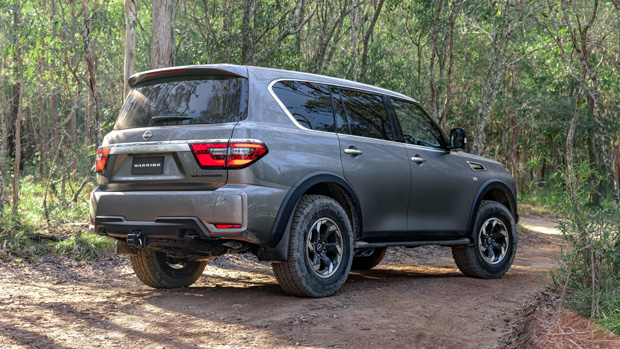
In revealing the 298kW (400hp) Patrol Warrior project to a group of media at Queensland’s Mt Cotton proving ground, the partnership finally confirmed one of the worst-kept secrets of this car’s automotive industry.
A desire to build a Patrol Warrior has been a hushed yet constant topic of conversation for at least four years, and strong supply of the ageing Y62-chassis Patrol, combined with still-booming demand for large four-wheel drives, created the conditions to allow the project to go ahead.
Like the Navara, the Patrol Warrior is essentially a Nissan-approved skunkworks project. The vehicle is technically signed off and warranted by Premcar, not the Nissan corporation – but the latter’s enthusiasm in marketing the project confirms its enthusiasm for Warrior.
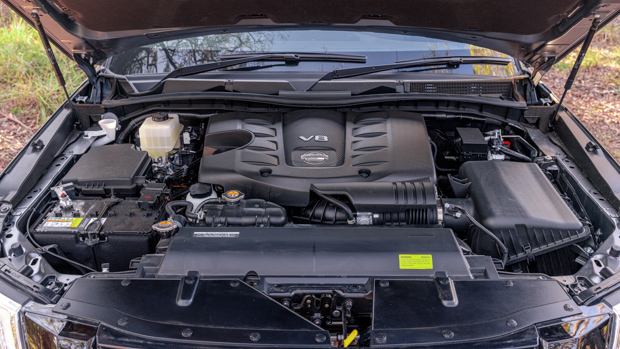
Also akin to the Navara project, Premcar has chosen not to alter the engine mechanicals of the Patrol.
If you’d hoped to see a Harrop supercharger here – that was knocked back due to what Premcar engineers saw as an improperly significant impact on fuel economy for the performance kick it would have delivered.
Instead, we’ve got the durable, characterful VQ56 5.6-litre naturally aspirated petrol V8 engine from the regular Patrol, making 298kW of power and 560Nm of torque. The engine feeds a permanent four-wheel-drive system via a seven-speed automatic transmission with a torque converter.
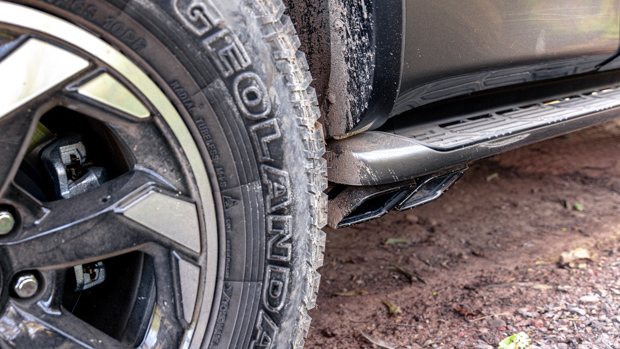
This engine has a lovely note, and Premcar has liberated it when compared to the relatively muffled stock Patrol by way of a bi-modal exhaust.
There is a party-piece side-exit exhaust on the driver’s side. Revving beyond 3500 rpm or so opens the valve for this – accelerate gently and the exhaust passes through to the standard single rear exhaust.
Pairing glitzy side-exit pipes with a nondescript standard exhaust looks ungainly, but doubts about the visual awkwardness go away once you get stuck into the throttle – either at a standstill or on the move.
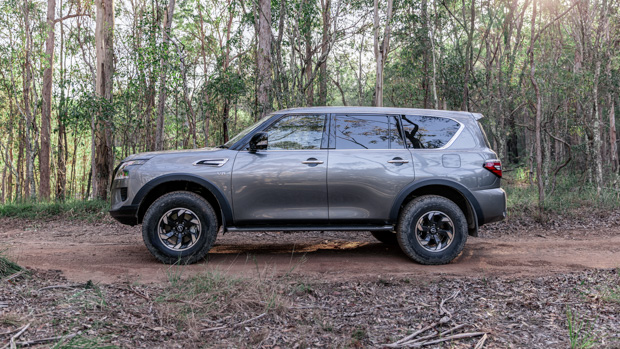
It’s a scintillating, loud experience, but one that sensibly avoids highway drone via the pass-through.
Considering the sonic effects, were we wrong to expect a Patrol Warrior that was a bit more visually tough?
It’s not a bad-looking rig, but the (properly moulded) fender flares look undercooked and the exclusive 18-inch wheel design is dated from the get-go. The Navara Warrior emerged looking hotter, tougher and more OEM-esque.
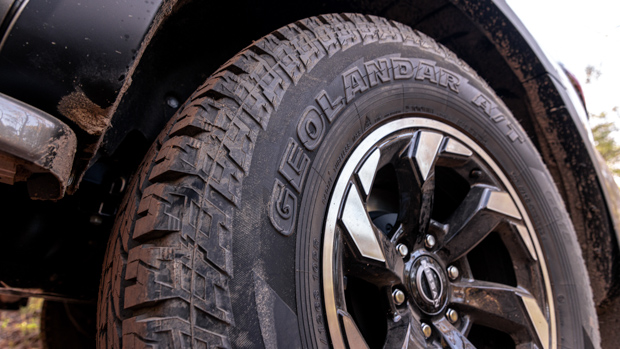
Without strapping a supercharger to it, a standard Y62 Patrol V8 can run a 7 to 7.5 sec 0-100km/h sprint. Thanks to knobbly Yokohama Geolandar 34.4-inch all-terrain tyres, expect to see acceleration knocked back slightly.
Still, it’s quick, and probably a little faster than the Toyota Land Cruiser 300 Series and its V6 diesel engine.
The tyre size increase is a big deal, especially as Premcar has thoughtfully redesigned and repositioned the tow bar in order to fit a full-size spare – something that was not possible with this tyre size before the re-engineering.
The Patrol’s 3500kg towing capacity is maintained; GVM is up 130kg to 3630kg.
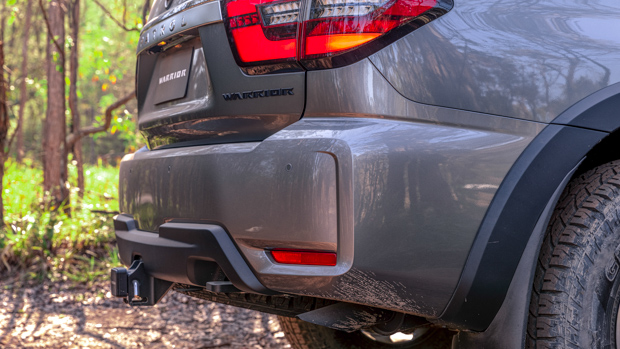
Like the engine, the brakes are stock, and we expect a marginally worse 100-0km/h stopping distance when we measure the Patrol Warrior at our test track later this year.
We’ll get to off-roading momentarily – but part of our assumption that emergency stops will be longer is that the on-road dynamics have suffered in the switch to the mud-ready Yokohamas.
We’re realistic about the size and weight (up 60kg to 2860kg) of the Patrol Warrior, but grip levels on dry pavement are very marginal – with electronic stability control remaining fully on, tail-out slides were far too easy to induce at the private road course we used for testing.
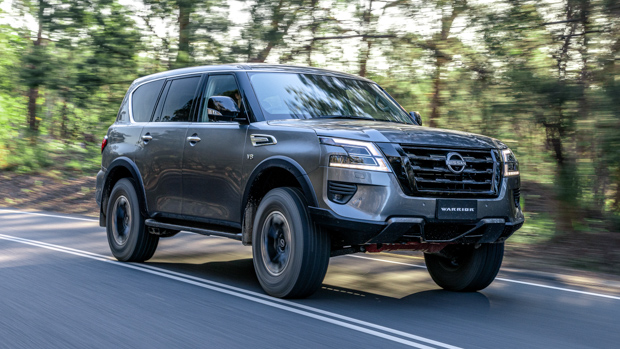
Even taking it easy, the light and disconnected steering feel combined with utterly ponderous cornering dynamics make it impossible to build confidence in the Patrol Warrior’s on-road demeanour.
Toyota’s Land Cruiser 300 Series GR Sport is similarly capable out of the box but feels more secure to steer on bitumen.
Turn onto a moderate to difficult trail, though, and the Patrol Warrior prototype makes a lot of sense: here’s a warranty-backed, off-road-ready Patrol you can drive off the showroom floor and onto a tough 4×4 course. That’s precisely what we did: the test cars had less than 100km on them…
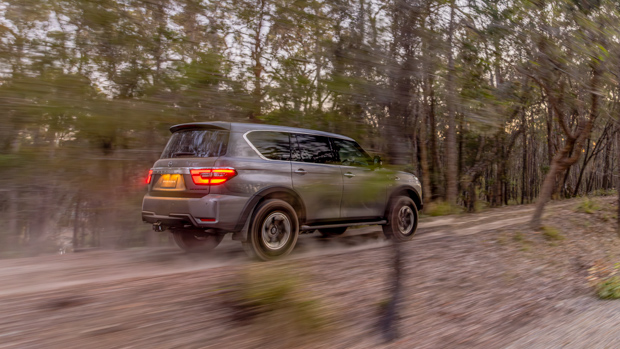
The standard two-speed transfer case can be operated once the vehicle has been brought to a stop, and low range engages quickly, albeit with a ‘thump’ that gives away the relative age of the platform when compared to the modern Land Cruiser’s relatively silent operation.
Most of Mt Cotton’s variable trails could be tackled easily enough in high range, thanks to the solid dirt bite of the Yokohamas and the Patrol Warrior’s 50mm suspension lift, which sees ground clearance increased beyond the Ti’s 272mm.
Nothing at this reasonably honest test course seriously challenged the Warrior and more hardcore testing will be required to find the car’s stock limits.
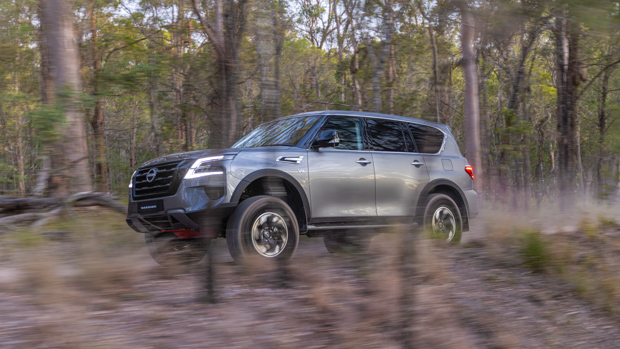
But for our tastes, as some-time recreational off-roaders, Mt Cotton’s narrow and rocky 4×4 course would be as far as we’d want to take a circa-$100K new vehicle anyway.
Speaking of price, the Patrol Warrior is likely to be much cheaper than a Land Cruiser GR Sport ($140,481).
We don’t know the price – and Nissan execs wouldn’t be drawn on the topic at all – but we can make a few educated guesses, as we know the Warrior is based on the cheaper of the two local Patrol grades – the $82,160 (plus ORCs) Ti model.
Looking to the Navara range for guidance, the Pro-4X Warrior grade is 15 percent dearer than the non-Warrior version.
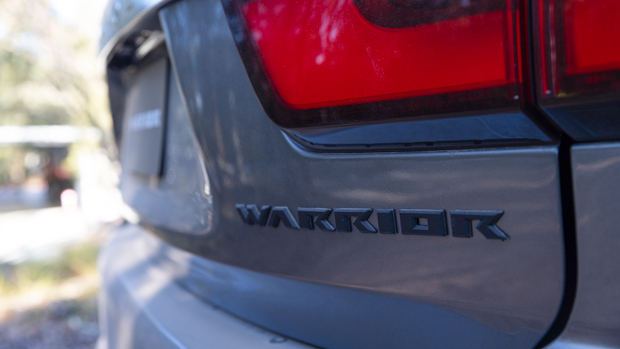
But the Patrol Warrior project is arguably more sophisticated and expensive for Premcar, building in exhaust, modifications to the hydraulic body control system and more extensive chassis adjustments.
So perhaps it’ll be 20 percent more expensive than the Patrol Ti – if so, that’d put the Warrior at a $98,990 or thereabouts, being more expensive than the current flagship Patrol Ti-L ($95,115).
For many buyers, those prices will sound entirely academic. Many of our readers and viewers report paying over the odds to secure a Patrol allocation sooner, and given the Warrior will be purchased through regular dealers, mark-ups might occur here too. We’ll see.
The decision to base the Warrior on the Ti specification was ostensibly made to keep the vehicle limited in height (it’s a very tall 1990mm). The Ti-L spec has stand-off roof rails which would have pushed the Warrior beyond two metres, scraping the roof on more car-park ceilings.
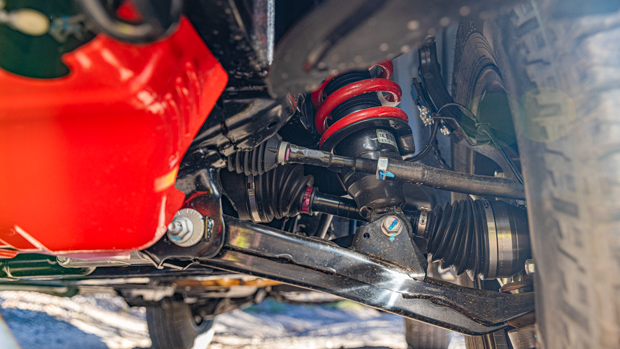
But the spec means that a number of premium features are missing, which will matter more to some than others.
Especially if the Warrior becomes the most expensive Patrol, we’d be wondering where the Ti-L’s exclusives like a 13-speaker Bose stereo, sunroof, heated and cooled seats, driver’s seat memory and a digital rear view mirror are…
Because the Warrior starts life as a Ti you simply cannot get heated seats, though the front pair are at least electrically-adjustable and a 360-degree camera is standard.
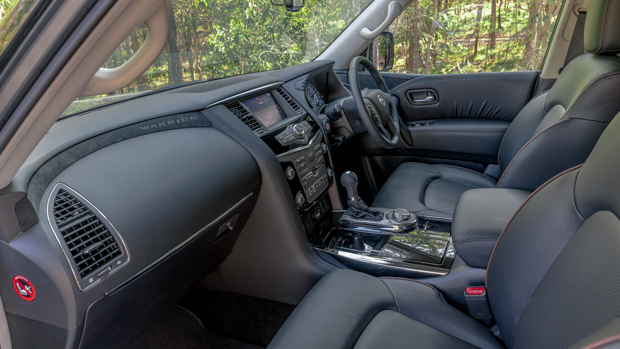
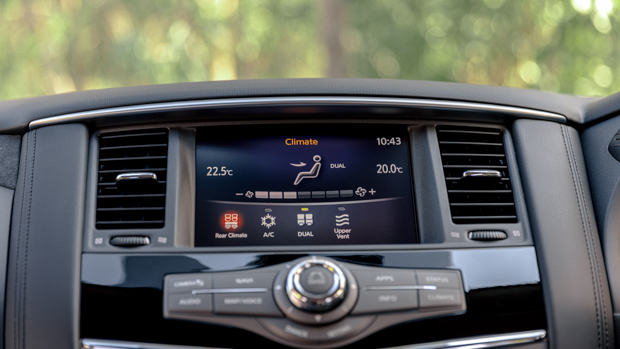
That said, when it’s displayed through an eight-inch and low-res touchscreen that seriously looks tiny against the vast scale of the Patrol’s interior, you have to wonder how much utility that screen has.
Premcar has wisely replaced the Patrol’s standard bright woodgrain trim with piano black and soft grey Alcantara interior pieces, but the standard Patrol interior remains for Australia.
Left-hand-drive Patrol markets scored a new interior years ago but local buyers are stiffed with a cabin that is ancient. It’s simply not good enough by Nissan.
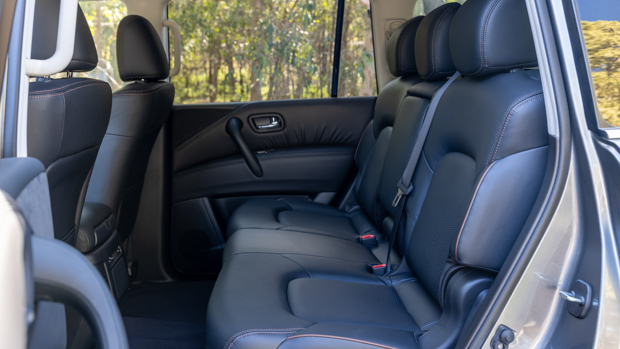
The Patrol remains a very solid buy when compared to a Land Cruiser, but compare their cabins and the result is so strongly in favour of the Toyota. The Patrol’s deficient interior is awkward rather than retro.
At least it’s very spacious, and the Warrior maintains the Patrol’s eight-seat trump card, with a roomy second row and a third row that you’ll get kids into, combined with a boot that still has space for school bags even with all seats in place.
Like other Patrols, the Warrior will be covered under Nissan’s capped-price servicing program that demands maintenance every six months or 10,000km – as does the Toyota Land Cruiser 300 Series. It’s a demanding schedule for high-milers.
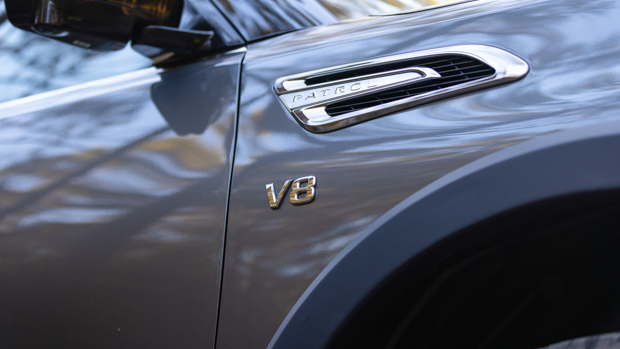
It probably goes without saying that the Patrol Warrior has a huge thirst for 95-octane (minimum) petrol. The claimed economy will be slightly worse than the Ti model’s 14.4L/100km rating – expect 20L/100km+ in town or on-trail and low teens on the highway.
There is a sensical argument that the exaggerated fuel consumption can be afforded from the savings banked by not purchasing a Land Cruiser – that’s true.
But for buyers that have an appreciation for their own impact on the pristine environments the Warrior is designed to access – some will regard the associated pollution as quite unfortunate.
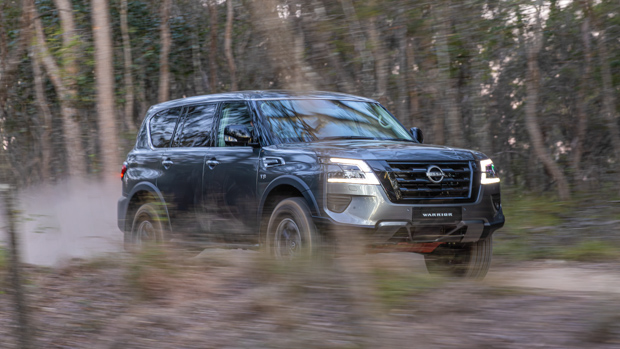
There is no hybrid model or diesel engine available with the Y62 platform, but word on the street suggests that the 2024 or 2025 Y63 Patrol will downsize to a twin-turbocharged V6 petrol engine.
We’ll need a fuller on- and off-road drive in the Patrol Warrior – and clearly, knowledge of its price – to come to a conclusion about this vehicle.
If Nissan can pull off a sharp price it could be a bargain off-road wagon when compared to its direct rival. If not, the Patrol Warrior will confirm its status as the mechanically capable – but deeply and clearly dated – rig that it is.
About Chasing cars
Chasing Cars reviews are 100% independent.
Because we are powered by Budget Direct Insurance, we don’t receive advertising or sales revenue from car manufacturers.
We’re truly independent – giving you Australia’s best car reviews.
The estimate provided does not take into account your personal circumstances but is intended to give a general indication of the cost of insurance, in order to obtain a complete quote, please visit www.budgetdirect.com.au. Estimate includes 15%^ online discount.
^Conditions Apply
Budget Direct Insurance arranged by Auto & General Services Pty Ltd ACN 003 617 909(AGS) AFSL 241 411, for and on behalf of the insurer, Auto & General Insurance Company Limited(ABN 42 111 586 353, AFSL 285 571).Because we don’t know your financial needs, we can’t advise you if this insurance will suit you. You should consider your needs and the Product Disclosure Statement before making a decision to buy insurance. Terms and conditions apply.
Indicative quote based on assumptions including postcode , 40 year old male with no offences, licence suspensions or claims in the last 5 years, a NCD Rating 1 and no younger drivers listed. White car, driven up to 10,000kms a year, unfinanced, with no modifications, factory options and/or non-standard accessories, private use only and garaged at night.
^Online Discounts Terms & Conditions
1. Discounts apply to the premium paid for a new Budget Direct Gold Comprehensive Car Insurance, Third Party Property Only or Third Party Property, Fire & Theft Insurance policy initiated online on or after 29 March 2017. Discounts do not apply to optional Roadside Assistance.
2. Discounts do not apply to any renewal offer of insurance.
3. Discounts only apply to the insurance portion of the premium. Discounts are applied before government charges, taxes, levies and fees, including instalment processing fees (as applicable). The full extent of discounts may therefore be impacted.
4. We reserve the right to change the offer without notice.